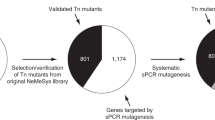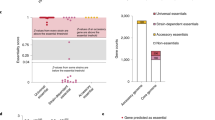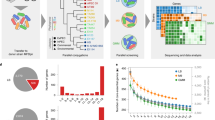Abstract
We have used comparative genomics to identify 26 Escherichia coli open reading frames that are both of unknown function (hypothetical open reading frames or y-genes) and conserved in the compact genome of Mycoplasma genitalium. Not surprisingly, these genes are broadly conserved in the bacterial world. We used a markerless knockout strategy to screen for essential E. coli genes. To verify this pheno-type, we constructed conditional mutants in genes for which no null mutants could be obtained. In total we identified six genes that are essential for E. coli (yhbZ, ygjD, ycfB, yfil, yihA, and yjeQ). The respective orthologs of the genes yhbZ, ygjD, ycfB, yjeQ, and yihA are also essential in Bacillus subtilis. This low number of essential genes was unexpected and might be due to a characteristic of the versatile genomes of E. coli and B subtilis that is comparable to the phenomenon of nonorthologous gene displacement. The gene ygjD, encoding a sialoglycoprotease, was eliminated from a minimal genome computationally derived from a comparison of the Haemophilus influenzae and M. genitalium genomes. We show that ygjD and its ortholog ydiE are essential in E. coli and B. subtilis, respectively. Thus, we include this gene in a minimal genome. This study systematically integrates comparative genomics and targeted gene disruptions to identify broadly conserved bacterial genes of unknown function required for survival on complex media.
This is a preview of subscription content, access via your institution
Access options
Subscribe to this journal
Receive 12 print issues and online access
$209.00 per year
only $17.42 per issue
Buy this article
- Purchase on Springer Link
- Instant access to full article PDF
Prices may be subject to local taxes which are calculated during checkout
Similar content being viewed by others
References
http://www.tigr.org.
Blattner, F.R. Plunkett III, G, Bloch, C.A. Perna, N.T., Burland, V., Riley, M. et al. 1997. The complete genome sequence of Escherichia coliK-12. Science 277: 1453–1462.
Mewes, H.W., Albermann, K., Bähr, M., Frishman, D., Gleissner, A., Hani, J. et al. 1997. Overview of the yeast genome. Nature (Suppl.) 387: 7–65.
Botstein, D., Chervitz, S.A., and Cherry, J.M. 1997. Yeast as a model organism. Science 277: 1259–1260.
Pohlschroder, M., Prinz, W.A., Hartmann, E., and Beckwith, J. 1997. Protein translocation in the three domains of life: variations on a theme. Cell 91: 563–566.
Mushegian, A.R., and Koonin, E.V. 1996. A minimal gene set for cellular life derived by comparison of complete bacterial genomes. Proc. Natl. Acad. Sci. USA 93: 10268–10273.
Basset, D.E., Jr Boguski, M.S., Spencer, F., Reeves, R. Kirn, S.-H., Weaver, T., and Hieter, P. 1997. Genome cross-referencing and XREFdb: Implications for the identification and analysis of genes mutated in human disease. Nat. Genet. 15: 339–344.
Hinton, J.C.D. 1997. The Escherichia coligenome sequence: the end of an era or the start of the FUN? Mol.Microbiol. 26: 417–422.
http://www.expasy.ch/cgi-bin/lists?ecoli.txt).
Higgins, C.F. 1992. ABC transporters: from microorganisms to man. Ann. Rev. Cell Biol. 8: 67–113.
Link, A.J., Phillips, D., and Church, G.M. 1997. Methods for generating precise deletions and insertions in the genome of wild-type Escherichia coli:application to open reading frame characterization. J. Bacteriol. 179: 6228–6237.
Hamilton, C.M., Aldea, M., Washburn, B.K., Babitzke, P., and Kushner, S.R. 1989. New method for generating deletions and gene replacements in Escherichia coli. J. Bacteriol. 171: 4617–4622.
Trach, K. and Hoch, J.A., 1989. Bacillus subtilis spoOBstage 0 sporulation operon encodes an essential GTP-binding protein. J. Bacteriol. 171: 1362–1371.
Maddock, J., Bhatt, A., Koch, M., and Skidmore, J. 1997. Identification of an essential Caulobacter crescentusgene encoding a member of the Obg family of GTP-binding proteins. J. Bacteriol. 179: 6426–6431.
Wach, A., Brachat, A., Pöhlmann, R., and Philippsen, P. 1994. New heterologous modules for classical or PCR-based gene disruptions in Saccharomyces cerevisiae. Yeast 10: 1793–1808.
Woese, C.R., Maniloff, J., and Zablen, L.B. 1980. Phylogenetic analysis of the mycoplasmas. Proc. Natl. Acad. Sci. USA 77: 494–498.
Fraser, C.M., Gocayne, J.D., White, O., Adams, M.D., Clayton, R.A., Fleischmann, R.D. et al. 1995. The minimal gene complement of Mycoplasma genitalium. Science 270: 397–403.
Himmelreich, R., Plagens, H., Hilbert, H., Reiner, B., and Herrmann, R. 1997. Comparative analysis of the genomes of the bacteria Mycoplasma pneumoniaeand Mycoplasma genitalium. Nucleic Acid Res. 25: 701 712.
Koonin, E.V., Tatusov, R.L., and Rudd, K.E. 1996. Protein sequence comparison at genome scale. Methods Enzymol. 266: 295–322.
Nesin, M., Lupski, J.R., Svec, P., and Godson, G.N. 1987. Possible new genes as revealed by molecular analysis of a 5 kb Escherichia colichromosomal region 5′ to the rpsU-dnaG-rpoDmacromolecular-synthesis operon. Gene 51: 149–161.
Abdullah, K.M., Lo, R.Y.C., and Mellors, A., 1991. Cloning, nucleotide sequence and expression of the Pasteurella haemolyticaA1 glycoprotease gene. J. Bacteriol. 173: 5597–5603.
Trias, J. and Gordon, E.M. 1997. Innovative approaches to novel antibacterial drug discovery. Curr. Opin. Biotechnol. 8: 757–762.
Altschul, S.F., Gish, W., Miller, W., Myers, E.W., and Lipman, D.J. 1990. Basic local alignment search tool. J. Mol. Biol. 215: 403–410.
Altschul, S.F., Madden, T.L., Schaffer, A.A., Zhang, J., Zhang, Z., Miller, W., and Lipman, D.J. 1997. Gapped BLAST and PSI-BLAST: a new generation of protein database search programs. Nucleic Acids Res. 25: 3389–3402.
Huang, X. and Miller, M. 1991. A time-efficient, linear-space local similarity algorithm. Adv. Appl. Math. 12: 337–357.
(http://ulrec3.unil.ch/software/PFSCAN_form.html).
Higgins, D.G. and Sharp, P.M. 1989. Fast and sensitive multiple sequence alignments on a microcomputer. CABIOS 5: 151–153.
Guzman, L.-M., Belin, D., Carson, M.J., and Beckwith, J. 1995. Tight regulation, modulation and high-level expression by vectors contining the arabinose PBAD promoter. J. Bacteriol. 177: 4121–4130.
Harwood, C.R., and Cutting, S.M. (eds.). 1990. Molecular biological methods for Bacillus. John Wiley & Sons, Chichester, UK
Guérout-Fleury, A.-M., Frandsen, N., and Stragier, P. 1996. Plasmids for ectopic integration in Bacillus subtilis. Gene 180: 57–61.
LeDeaux, J.R. and Grossman, A.D. 1995. Isolation and characterization of kinC, agene that encodes a sensor kinase homologous to the sporulation sensor kinas-es KinA and KinB in Bacillus subtilis. J. Bacteriol. 177: 166–175.
Baudin, A., Ozier-Kalogeropoulos, O., Denouel, A., Lacroute, F., and Cullin, C., 1993. A. simple and efficient method for direct gene deletion in Saccharomyces cerevisiae. Nucleic Acids Res. 21: 3329–3330.
Tomb, J.-F., White, O., Kerlavage, A.R., Clayton, R.A., Sutton, G.G., Fleischmann, R.D. et al. 1997. The complete genome sequence of the gastric pathogen Helicobacterpylori. Nature 388: 539–547.
Fraser, C.M., Casjens, S., Huang, W.M., Sutton, G.G., Clayton, R., Lathigra, R. et al. 1997. Genomic sequence of a Lyme disease spirochaete, Borrelia burgdorferi. Nature 390: 580–586.
Author information
Authors and Affiliations
Rights and permissions
About this article
Cite this article
Arigoni, F., Talabot, F., Peitsch, M. et al. A genome-based approach for the identification of essential bacterial genes. Nat Biotechnol 16, 851–856 (1998). https://doi.org/10.1038/nbt0998-851
Received:
Accepted:
Published:
Issue Date:
DOI: https://doi.org/10.1038/nbt0998-851
This article is cited by
-
Reconstituted cell-free protein synthesis using in vitro transcribed tRNAs
Communications Biology (2020)
-
Auxotrophy to Xeno-DNA: an exploration of combinatorial mechanisms for a high-fidelity biosafety system for synthetic biology applications
Journal of Biological Engineering (2018)
-
Stabilizing displayed proteins on vegetative Bacillus subtilis cells
Applied Microbiology and Biotechnology (2018)
-
The Neisseria gonorrhoeae Obg protein is an essential ribosome-associated GTPase and a potential drug target
BMC Microbiology (2015)
-
Potential mechanisms of attenuation for rifampicin-passaged strains of Flavobacterium psychrophilum
BMC Microbiology (2015)



